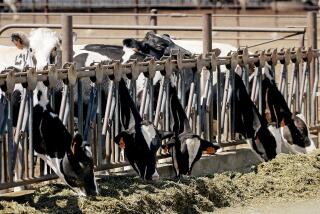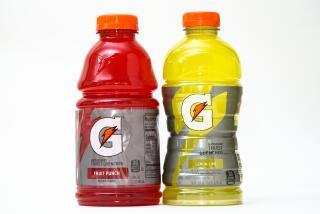The hidden costs of some cheap food
- Share via
Maybe cheap food is more expensive than we think. Capital Press, an agriculture publication that covers the Western United States, reports that the use of rBST, a synthetic hormone that boosts milk production, is plummeting among U.S. dairy operations. And the reason is surprising: It’s all about economics.
More than two-thirds of the American dairies that at some point used rBST have stopped, according to a study by a University of Alberta researcher. Among large dairies, use dropped from 44% in 2005 to 16% in 2010.
The hormone does what it says, which theoretically would raise profits. But getting that productivity benefit requires such close monitoring of the cows’ feed that the numbers weren’t penciling out for most dairies, according to the study. Dairies often found themselves spending as much or more on feed as they were gaining by having more milk to sell.
YEAR IN REVIEW: The good, the bad and the hopeful in wilderness news
In addition, because many consumers rejected milk produced with the controversial hormone, the dairies found fewer outlets to buy their milk.
The study raises anew questions about whether food technologies intended to reduce costs actually do so.
In the case of antibiotics used to promote growth in livestock and prevent disease in crowded pens, the agriculture industry argued for years that the medications were necessary to keep prices down. But evidence has gathered over the years that consumers pay dearly in the form of resistant infections that kill 23,000 people a year, sicken millions and cost the country $23 billion annually. It’s unclear exactly how much of that is caused by agriculture alone; doctors continue to overprescribe antibiotics, though less so each year. But 80% of antibiotics in this country are used in agriculture, not on people.
Of course, that’s not counting the research and development that goes into researching such illnesses or trying to develop new, more powerful antibiotics. Nor does it count the actual price of the antibiotics that are routinely added to livestock feed.
We might get a better picture of real costs in years to come, now that the FDA has moved to ban medically important antibiotics as a growth booster and sharply reduce their use to prevent, rather than treat, disease in livestock. Will prices rise? Will prevalence of tough-to-cure infections drop, or at least not worsen?
There might be a similar scenario when it comes to crops that have been genetically engineered to withstand spraying with the herbicide glyphosate, better known by the brand name Roundup. As with the overuse of antibiotics, there is mounting evidence that the intensive herbicide spraying that is possible with these crops has contributed to the rise of glyphosate-resistant superweeds. The producers of these crops already are asking federal permission for a new generation of these crops that can resist tougher herbicides. And what will be the cost to farms as well as the environment to battle weeds that can stand up to even stronger pesticides?
The answer isn’t known, but we should at least be asking more questions about these and other methods that boost productivity, a supposed economic benefit. Setting aside for the moment controversies about health and humane treatment and focusing only on the financial aspect: Is cheap food truly inexpensive?
ALSO:
Are America’s students falling behind the world?
Monday morning massacre at L.A. Sheriff’s Dept.
Elect, don’t appoint, to replace Marguerite Poindexter LaMotte
More to Read
A cure for the common opinion
Get thought-provoking perspectives with our weekly newsletter.
You may occasionally receive promotional content from the Los Angeles Times.






